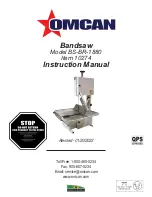
www.scheppach.com
+(49)-08223-4002-99
+(49)-08223-4002-58
23 І 164
4. Loosen the mounting bolt (24) in order to pull out
the splitting wedge (6) until the right distance is
adjusted (fig. 10).
5.
Tighten the mounting screw (24) again and mount
the bench insert (2).
8.4 Mounting / dismounting the saw blade guard
(figs. 11-12)
1. Mount the saw blade guard (6) together with the bolt
(25) on top of the riving knife (6), so that the bolt is
firmly seated in the slot of the riving knife (6).
2. Do not screw in the bolt (25) too tightly; the saw
blade guard (6) must move freely.
3. Plug the suction hose (5) onto the suction adapter
(26) and the connecting piece of the saw blade
guard (4). Connect a suitable splint collector onto
the suction adapter (26).
4.
Disassembly is performed in reverse order.
Caution!
The saw blade guard (4) must be lowered onto
the workpiece before starting the sawing opera
-
tion.
8.5 Replacing the bench insert (fig. 8)
1.
In case of wear or damage, the bench insert (2)
must be replaced; otherwise, there is an increased
risk of injury.
2. Unfasten the bolt (23) using a Phillips screwdriver.
3. Take out the worn bench insert (2).
4.
The installation of the new bench insert is done in
reverse order.
8.6 Installing / replacing the saw blade (fig. 13)
1.
Caution! Pull out the main plug and wear safety
gloves.
2.
Dismount the saw blade guard (4) (see 8.4)
3. Remove the bench insert (2) (see 8.5)
4.
Loosen the nut by placing a saw blade spanner
(21a) on the nut while holding up another saw blade
spanner (21b) on the motor shaft (see fig. 22).
5.
Caution!
Turn the nut in the direction of rotation of
the saw blade.
6. Remove the outer flange and remove the old blade
inner flange.
7.
Clean the saw blade flange thoroughly with a wire
brush before mounting the new saw blade.
8. Insert the new saw blade in reverse order and
tighten.
Caution! Note the direction of run, the cutting
slope of the teeth must be in the direction of run,
i.e. facing forward.
9. Remount and adjust the bench insert (2) and saw
blade guard (4) (see 8.4 and 8.5)
10.
Before you start working again with the saw, check
proper functioning of the safety equipment.
9. Using the saw
9.1 On/Off switch (Fig. 14)
- The saw can be switched on by pressing the green
pushbutton „I“. (11)
-
The red pushbutton „0“ (11) has to be pressed to
switch off the saw.
9.2 Cutting depth (Fig. 14)
Turn the round handle (12) to set the blade (3) to the
required cutting depth.
- Anticlockwise: smaller cutting depth
- Clockwise: larger cutting depth
After each new adjustment it is advisable to carry out a
trial cut in order to check the set dimensions.
8. Attachment
Important. Pull out the power plug before carrying
out any maintenance, resetting or assembly work on
the circular saw!
Place all parts supplied on a flat surface. Grouping
equal parts.
Note:
If compounds with a bolt (round head / or hexa
-
gon), hex nuts and washers are backed up, the washer
must be fitted under the nut.
Insert screws each from outside to inside. Secure con-
nections with nuts on the inside.
Note:
Tighten the nuts and bolts during assembly only
to the extent that they can not fall down.
If you tighten the nuts and bolts prior to final assembly,
final assembly can not be performed.
8.1 Mounting the bench extension (fig. 5)
1. Turn the saw and place it on the floor with the
bench facing down.
2.
Align the bench extension (8) flush with the saw
bench (1).
3.
Push table extension (8) onto the sawing table
(1) using the hex bolts (19) and loosely fasten the
spring washers (20a), washers (20b) and hex nuts
(20). Repeat for the opposite side.
4. Screw the support struts (22) to the table extensi
-
ons (8) with the hex bolts (19), spring washer (20a),
and washers (20b).
5. Subsequently, tighten all screws.
8.2 Mounting rack (figs. 6-7)
1. Screw the four support legs (18) together with the
support struts (22) onto the saw with the hex bolts
(19), the spring rings (20a) and the washers (20b)
(fig. 6). For this use the saw blade key (21a), part of
the delivery contents (fig. 6).
2.
Now place the rubber feet (16a) onto the support
legs (16) (fig. 6.1).
3.
Now, screw the long centre brace (18) and the short
centre brace (17) onto the legs (16) using the hexa
-
gon head bolts (19) and the hexagon head nuts (20).
Make sure that the same braces face each other.
The long centre braces (18 - marked „B“) must
be mounted parallel to the operator‘s side of the
saw. (Fig. 7).
4. Using two hex bolts (19) on each, loosely secure the
spring washers (20a), washers (20b) and hex nuts
(20) at the drill holes of the rear support legs of the
support frame (16b) (fig. 7.1).
Attention!
Both support frames must be fastened to the
back of the machine!
5. Then, tighten all the nuts and bolts of the under-
frame.
8.3 Setting / mounting the riving knife (figs. 8-10)
m
The setting Caution! Pull out the main plug!
The setting of the riving knife (6) must be checked
prior to commissioning. of the riving knife (6) must
be checked prior to commissioning.
1. Set the saw blade (3) to the max. cutting depth,
bring it to the 0° position and lock it.
2. Unfasten the bolt (23) from the bench insert (2)
using a Phillips screwdriver, and remove bench
insert (22) (fig.8).
3. The distance between the saw blade (3) and the
riving knife (6) must be max. 5 mm. (Fig. 9)
















































